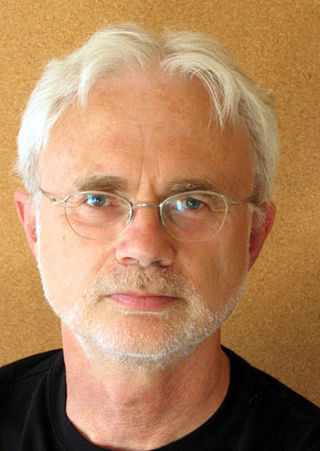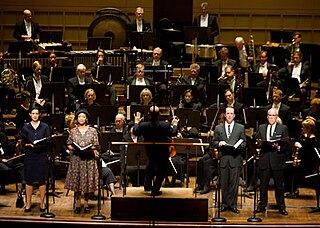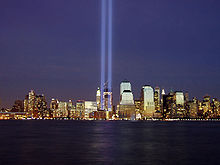
John Coolidge Adams is an American composer and conductor. Among the most regularly performed composers of contemporary classical music, he is particularly noted for his operas, many of which center around historical events. Apart from opera, his oeuvre includes orchestral, concertante, vocal, choral, chamber, electroacoustic, and piano music.
EXPO is an orchestral composition by the Finnish composer Magnus Lindberg. It was the first work commissioned by the New York Philharmonic under the conductor Alan Gilbert, and was Lindberg's first commission as the orchestra's composer-in-residence. The piece was first performed on September 16, 2009 at Avery Fisher Hall, New York City, during Alan Gilbert's inaugural concert with the New York Philharmonic. EXPO was the first newly commissioned work to open the New York Philharmonic's concert season since the premiere of Aaron Copland's Connotations under Leonard Bernstein on September 23, 1962.

Magnus Gustaf Adolf Lindberg is a Finnish composer and pianist. He was the New York Philharmonic's composer-in-residence from 2009 to 2012 and has been the London Philharmonic Orchestra's composer-in-residence since the beginning of the 2014–15 season.

Steven Edward Stucky was a Pulitzer Prize-winning American composer.
Century Rolls is a piano concerto by the American composer John Adams. Commissioned by Emanuel Ax, the work dates from 1997. Ax was the soloist in the concerto's premiere on September 25, 1997 in Cleveland, Ohio, with Christoph von Dohnányi conducting The Cleveland Orchestra. Ax, von Dohnányi and The Cleveland Orchestra made the first commercial recording of the concerto, for Nonesuch. Adams himself conducted the UK premiere on 1 November 1998, again with Ax as the piano soloist.
Christopher Chapman Rouse III was an American composer. Though he wrote for various ensembles, Rouse is primarily known for his orchestral compositions, including a Requiem, a dozen concertos, and six symphonies. His work received numerous accolades, including the Kennedy Center Friedheim Award, the Grammy Award for Best Classical Contemporary Composition, and the Pulitzer Prize for Music. He also served as the composer-in-residence for the New York Philharmonic from 2012 to 2015.
Mark Grey is an American classical music composer, sound designer and sound engineer.
Anna Clyne is an English composer resident in the USA. She has worked in both acoustic music and electroacoustic music.
Naive and Sentimental Music is a symphonic work by American composer John Adams. The title of the work alludes to an essay by Friedrich Schiller, On Naïve and Sentimental Poetry, that contrasts a creative personality that creates art for its own sake versus one conscious of other purposes, such as art’s place in history. The composer cites both the slowly developing harmonies of Bruckner's Fourth Symphony and the atmosphere of the Sonoma coastline as inspirations for the work. The piece was co-commissioned by the Los Angeles Philharmonic, the Ensemble Modern, the Vancouver Symphony Orchestra, and the Sydney Symphony Orchestra. It received its first public performance by the Los Angeles Philharmonic conducted by Esa-Pekka Salonen on February 19, 1999. A recording by Salonen and the Los Angeles Philharmonic was subsequently released by Nonesuch Records.
Soundings is an orchestral composition by the American composer Elliott Carter. The work was commissioned by the Chicago Symphony Orchestra for their final season with the conductor Daniel Barenboim as music director. It was first performed on October 6, 2005 at the Symphony Center, Chicago, by Barenboim and the Chicago Symphony Orchestra.
One Sweet Morning is a four-movement song cycle for mezzo-soprano solo and orchestra by the American composer John Corigliano. The work was jointly commissioned by the New York Philharmonic and the Shanghai Symphony Orchestra to commemorate the 10th anniversary of the September 11 attacks. It was given its world premiere on September 30, 2011, by the mezzo-soprano Stephanie Blythe and the New York Philharmonic under the conductor Alan Gilbert. The piece is dedicated to the memory of Natalie and Serge Koussevitzky.
Scheherazade.2 is a dramatic symphony for solo violin and orchestra by the American composer John Adams. The work was jointly commissioned by the New York Philharmonic, the Concertgebouw & the Royal Concertgebouw Orchestra, and the Sydney Symphony Orchestra. It was written specifically for the violinist Leila Josefowicz, who performed its world premiere with the New York Philharmonic under Alan Gilbert at Avery Fisher Hall on March 26, 2015.
The Piano Concerto No. 2 is a composition for solo piano and orchestra by the Finnish composer Magnus Lindberg. The work was jointly commissioned by the Royal Concertgebouw Orchestra, the Gothenburg Symphony Orchestra, and the New York Philharmonic, for which Lindberg was then composer-in-residence. It was given its world premiere at Avery Fisher Hall on May 3, 2012 by the pianist Yefim Bronfman and the New York Philharmonic under the direction of Alan Gilbert.
Souvenir is a composition for chamber orchestra by the Finnish composer Magnus Lindberg. The work was commissioned by the New York Philharmonic, for which Lindberg was then composer-in-residence. It was given its world premiere on November 19, 2010 at Symphony Space, New York City, by the New York Philharmonic under the direction of Alan Gilbert. The piece was written in memoriam for Lindberg's friend and fellow composer Gérard Grisey.
Polaris: Voyage for Orchestra is an orchestral composition by the British composer Thomas Adès. The work was co-commissioned by the New World Symphony under the direction of Michael Tilson Thomas for the opening of the New World Center. The New World Symphony was joined in commission by the Royal Concertgebouw Orchestra, the New York Philharmonic, the Calouste Gulbenkian Foundation, the Barbican Centre, the Los Angeles Philharmonic, and the San Francisco Symphony. It was given its world premiere by Michael Tilson Thomas and the New World Symphony at the New World Center in Miami Beach on January 26, 2011.
America: A Prophecy (sometimes stylized as America (A Prophecy)) is a composition for mezzo-soprano and orchestra with an optional chorus by the British composer Thomas Adès. The work was commissioned by the New York Philharmonic with financial contributions from the Francis Goelet Fund. It was given its world premiere by the mezzo-soprano Beth Clayton, the Westminster Symphonic Choir, and the New York Philharmonic under the direction of Kurt Masur at Avery Fisher Hall on November 11, 1999.
Vocalise is a composition for soprano, electronics, and orchestra by the American composer John Corigliano. The work was commissioned by the New York Philharmonic under the direction of Kurt Masur with financial contributions from the Francis Goelet Fund. It was given its world premiere by the soprano Sylvia McNair and the New York Philharmonic under Masur at Avery Fisher Hall on November 11, 1999. The piece is dedicated to Sylvia McNair.
Al largo is a composition for orchestra by the Finnish composer Magnus Lindberg. It was commissioned by the New York Philharmonic while Lindberg served as the orchestra's composer-in-residence. Its world premiere was given by the New York Philharmonic under the direction of Alan Gilbert at Avery Fisher Hall on June 23, 2010.
Karawane is a composition for chorus and orchestra by the Finnish composer Esa-Pekka Salonen. The work was jointly commissioned by the Tonhalle Orchester Zürich, the Swedish Radio Symphony Orchestra, the New York Philharmonic with support from the philanthropist Marie-Josée Kravis, the Bamberg Symphony, and the Finnish Radio Symphony Orchestra. It was first performed by the Tonhalle Orchester Zürich and the Zürcher Sing-Akademie conducted by Lionel Bringuier in the Tonhalle, Zürich, on September 10, 2014. The piece is set to the eponymous poem by the German author and Dadaist Hugo Ball.
The Piano Concerto is a composition for piano and orchestra by the Austrian composer Heinz Karl Gruber. The work was commissioned for the pianist Emanuel Ax by the New York Philharmonic, the Royal Stockholm Philharmonic Orchestra, the Berlin Philharmonic, and the Tonhalle Orchester Zürich. It was composed from 2014 through 2016 and was given its world premiere by Emanuel Ax and the New York Philharmonic under the direction of Alan Gilbert at David Geffen Hall on January 5, 2017.



